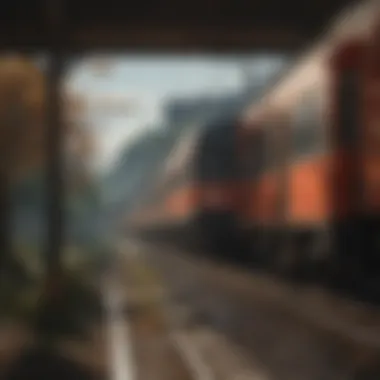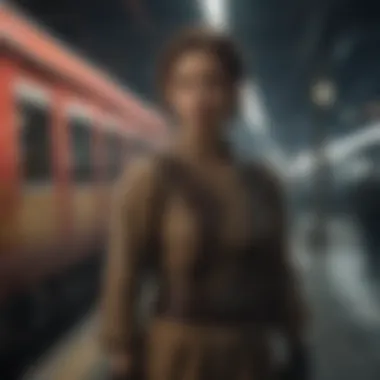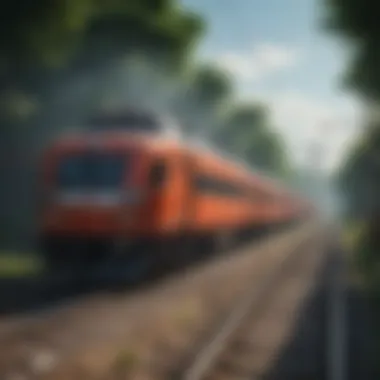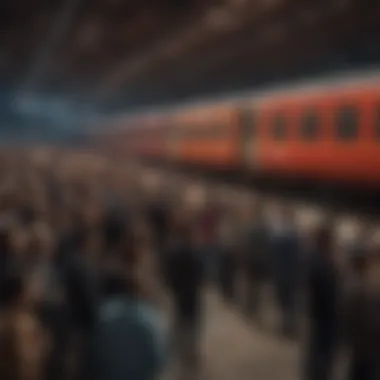Significance of 'Demon Slayer: Mugen Train' on HBO Max


Intro
The world of anime has made waves across the globe, morphing into a cultural phenomenon that resonates deeply with fans of all ages. Among the standout additions to this vibrant landscape is Demon Slayer: Mugen Train, a film that not only captivated audiences in Japan but also made its mark on international platforms such as HBO Max. This article dives into its significance in the broader context of anime adaptations, critically examining its storyline, character arcs, and stunning animation.
This journey will take us through various aspects of the film, including a comprehensive analysis of its impact and reception, while also shedding light on HBO Max’s role in this anime’s distribution. For fans and newcomers alike, understanding this film could provide a clearer picture of anime's evolving presence in contemporary entertainment.
Demon Slayer: Mugen Train Overview
The significance of "Demon Slayer: Mugen Train" cannot be overstated, especially in the context of anime adaptations in today's streaming landscape. As a high-grossing film, it has not only broken box office records but also redefined the parameters of storytelling within the anime genre. This section aims to provide a foundational understanding of what makes this film important, touching on its narrative, characters, animation style, and cultural impact.
Synopsis of the Film
"Demon Slayer: Mugen Train" picks up directly where the first season of the anime left off. Tanjiro Kamado, along with his companions N zoomy Kamado and Zenitsu Agatsuma, boards the Mugen Train, where a series of mysterious disappearances have occurred. They join Kyojuro Rengoku, the Flame Hashira, a formidable demon slayer. As they embark on their journey, the heroes face not just physical battles against powerful demons, but also psychological skirmishes that tap into their fears and memories.
The plot intricately weaves the character's backstories into the narrative, enriching the experience for audiences. Each character wrestles with their own demons—literal and metaphorical—providing depth and emotional resonance that sets this film apart from typical shonen narratives. Ultimately, it’s a tale of friendship, sacrifice, and the relentless pursuit of hope in darkness.
Key Themes and Motifs
The themes in "Mugen Train" are profoundly woven into the fabric of the story, making it resonant on multiple levels. Here are some key motifs:
- The Power of Dreams: Dreams play a crucial role in the plot. They represent both the desires and fears of the characters, showcasing their inner battles. The characters are often confronted by what they yearn for, only to be reminded of reality’s harshness.
- Sacrifice: Throughout the film, the notion of sacrifice surfaces repeatedly. The characters face situations where personal costs must be weighed against the greater good, inviting viewers to reflect on what it means to put others before oneself.
- The Cycle of Life and Death: This theme reverberates through the experiences of both Tanjiro and Nezuko, who confront the fragility of life amidst their struggles against demons. It touches on the inevitability of loss, yet highlights the enduring connection between loved ones.
"In an ever-darkening world, hope often sprinkles the path, yet it is the sacrifices made that truly illuminate the way."
The Significance of HBO Max
HBO Max has transformed the landscape of streaming, especially with its commitment to diverse content. In the world of anime, its importance cannot be overstated; the platform serves as a crucial gateway for viewers new to the genre and long-time fans alike. Within this context, Mugen Train has earned its place not only as a phenomenal film but also as a keystone in HBO Max’s anime portfolio.
The platform's strategy includes acquiring popular anime titles, enabling fans who might not venture into traditional networks or services a chance to engage with acclaimed animated works. Not to mention, it creates an environment where Demon Slayer can thrive by giving it a baseline for visibility against competition in a saturated market.
HBO Max's Role in Streaming Anime
HBO Max has carved out a niche for itself in the streaming wars by prioritizing quality over sheer quantity. With respect to anime, this means carefully curated selections, rather than a sprawling assortment of lesser-known titles. This focus not only reflects strategic marketing efforts but also recognizes a growing appreciation for animated storytelling globally.
Moreover, the platform's investment in exclusive partnerships allows the airing of shows that otherwise might remain limited to certain regions. For instance, shows like Demon Slayer: Mugen Train benefit from this broader distribution, reaching audiences from various backgrounds and increasing its prestige. The attention to detail in both localization and dubbing has further solidified HBO Max’s status as a prime player in the anime landscape.
- Curated Content: Ensuring that only the best titles make it onto the service.
- Global Reach: Expanding access to international hits, like Demon Slayer, in markets where they may have been slow to become popular.
- High-Quality Adaptations: Prioritizing dubbed and subbed versions that respect the original material while making it accessible to wider audiences.
Impact on Audience Reach
The impact of HBO Max on audience reach cannot be ignored. With its user-friendly interface and robust library, the service democratizes access to high-quality anime. By streaming films like Mugen Train, HBO Max engages a demographic that spans from younger audiences to those with more refined tastes in storytelling. Additionally, it becomes a home for casual viewers and hardcore anime fans alike, drawing in individuals who might have been hesitant to explore anime previously.


- Variety of Genres: Offers a range of genres beyond just action-oriented narratives, appealing to romance, comedy, and slice-of-life enthusiasts.
- Community Engagement: With integration of social media, HBO Max encourages discussions, fan theories, and shared passion among viewers.
- Impact on Trends: The popularity of titles featured on HBO Max significantly influences what’s trending in anime culture, spurring a cycle of curiosity and exploration among fans.
"HBO Max is not just a streaming platform; it's a cultural phenomenon reshaping how audiences consume anime and engage with its richness."
In summary, HBO Max plays a pivotal role in connecting diverse audiences with anime like Demon Slayer: Mugen Train. By focusing on quality content and accessibility, it becomes both a business model and a community hub, empowering millennials and Gen Z viewers, who crave innovative storytelling in animated form.
In-depth Character Analysis
Understanding the characters in "Demon Slayer: Mugen Train" adds layers to one’s viewing experience. Each character embodies unique traits and philosophies that not only propel the plot forward but also resonate with broader themes such as resilience, loyalty, and sacrifice. Analyzing these characters provides a richer context for their actions and decisions, enhancing the emotional weight of the narrative. Moreover, as the anime passionately explores the human condition, detailed character analyses reveal how personal motivations intersect with the universe of demon slaying.
Tanjiro Kamado: The Relentless Hero
Tanjiro Kamado is the embodiment of determination and compassion. From the outset, he stands out as more than just a fighter; he is a character driven by a profound sense of purpose. Following the brutal murder of his family and the transformation of his sister Nezuko into a demon, Tanjiro's journey begins as one of vengeance but swiftly evolves into a quest for understanding and redemption.
His resilience shines through in every battle he faces. For instance, during his encounters in Mugen Train, Tanjiro not only fights demons but also struggles against despair and trauma. He often reflects on the pain he feels but channels it into his fight for his loved ones. This depth is something many viewers connect with, making Tanjiro a relatable hero. His struggles and triumphs resonate with anyone who has faced hardship, showcasing a remarkable portrayal of personal growth in the face of overwhelming adversity.
Nezuko Kamado: The Evolving Protector
Nezuko Kamado’s journey is equally compelling, as it dives deep into themes of identity and sacrifice. Initially, she is introduced as a traditional demon with an insatiable hunger for human flesh. But as the story progresses, Nezuko evolves into a nuanced character who is both protector and warrior. She embodies a unique balance between the instincts of a demon and the emotional bonds of humanity.
Her relationship with Tanjiro is the linchpin of her character development. From helping her brother alleviate the grueling battles he faces, to showing restraint in her demon urges, Nezuko's growth illustrates the complexities of her dual existence. Audiences witness her unique skill set, especially her blood demon art, which illustrates not just her power but also her willingness to adapt for the sake of her family. This dynamic portrayal of Nezuko emphasizes the importance of loyalty, even when one is caught between two worlds.
Kyojuro Rengoku: The Flame Hashira
Kyojuro Rengoku, known as the Flame Hashira, brings a fiery presence to the film. His fiery spirit and unwavering dedication to the fight against demons present a stark contrast to both Tanjiro and Nezuko. Rengoku is driven by a keen sense of duty and pride, standing as a beacon of hope and inspiration, especially for his fellow demon slayers.
One cannot overlook his tragic heroism throughout "Mugen Train". Rengoku’s too-brief interactions showcase a character who embodies both bravery and vulnerability. His willingness to protect others, even at the cost of his own life, serves as a poignant reminder of the stakes involved in the battle against evil. Viewers are left with a lasting impression of Rengoku not just as a powerful fighter, but as a character whose legacy influences those around him significantly.
"The true measure of one's strength is not in their ability to fight, but in their capacity to love and protect their loved ones."
Through the character analysis of Tanjiro, Nezuko, and Rengoku, we can see the multifaceted approach "Demon Slayer: Mugen Train" takes toward storytelling. Each character adds richness to the narrative, urging the audience to reflect on their own values and relationships. This depth ensures that the film resonates beyond its thrilling plot, firmly rooting its emotional impact in the characters' journeys.
Animation and Art Style
The animation and art style of Demon Slayer: Mugen Train is not just a coat of paint on a simple story; it’s a vibrant tapestry that enhances every moment of the film. It sets the stage, creates mood, and immerses the viewer in a world where every frame is crafted with meticulous care. This section will explore why the animation and art style are pivotal to its success and audience appeal, particularly on a streaming platform like HBO Max.
Visual Aesthetics of Mugen Train
In Demon Slayer: Mugen Train, the visual aesthetics are breathtaking, blending traditional hand-drawn techniques with modern digital artistry. From the moment the film begins, the colors leap off the screen. Every scene feels alive, with rich hues that capture the essence of the characters' emotions and the dark themes they navigate. Take, for instance, the use of warm oranges and reds during intense battle scenes. These colors embody the spirit of the characters while heightening the stakes of their struggles.
- The backgrounds often draw inspiration from Japanese landscapes, giving the film an authentic feel that resonates with fans of both anime and traditional art.
- Character designs are unique and richly detailed, allowing viewers to connect deeply with them on a personal level. Tanjiro’s kind eyes and Nezuko’s transformation from human to demon are visually represented with care.
This emphasis on aesthetics does more than please the eye; it consolidates the storytelling by visually contextualizing characters’ journeys. When Tanjiro faces overwhelming odds, the chilling blues and grays envelop him, visually echoing his despair. The blend of light and shadow adds to the emotional depth. A character’s gaze can tell a story, and this film uses visual cues effectively to enhance emotional moments that words alone cannot convey.


Innovative Techniques in Animation
The animation techniques used in Demon Slayer: Mugen Train showcase a blend of innovation and tradition. The studio Ufotable, known for its high standards, employs several techniques that push the boundaries of animation:
- Dynamic Camera Angles: Unlike many anime films that use static frames, Mugen Train utilizes dynamic camera movements. This approach adds an element of realism and an immersive experience. The angles shift during battles; viewers feel as if they are alongside Tanjiro in the heat of the fight.
- Digital Effects: The integration of digital effects to simulate elements like fire and water is striking. For example, the Flame Hashira, Kyojuro Rengoku, summons fire in ways that breathe life into his character, making the flames dance and flicker realistically around him.
"The fluidity of the animation is a dance of brush and pixel, transcending the medium to create not just a film but a moving painting."
- Hybrid Techniques: Mugen Train often blends CG with traditional hand-drawn elements. This fusion enables the film to maintain the nuances of hand-drawn artistry while enriching certain sequences with depth through computer-generated graphics. The blending is so seamless that detecting where one ends, and the other begins can be a challenge, elevating the overall visual storytelling.
Cultural Context and Relevance
Understanding the cultural context of Demon Slayer: Mugen Train is crucial, especially as it reflects anime’s rapid evolution and integration into the global entertainment landscape. This film, as part of the larger Demon Slayer franchise, does not just tell a story; it represents a cultural movement that has captured the attention of audiences worldwide. Its blend of compelling narratives, dynamic characters, and stunning visuals speaks to both traditional and contemporary themes that resonate deeply with viewers.
Anime's Evolution in Global Culture
Anime, once considered niche, has grown into a dominant force in global pop culture. The ascent can largely be traced back to the turn of the millennium when titles such as Naruto, One Piece, and Dragon Ball Z began breaking barriers. However, Demon Slayer exemplifies a new wave, combining high-quality animation with rich storytelling that appeals to diverse age groups.
- Cultural Fusion: Today's anime often melds Japanese culture with global themes. For instance, while Demon Slayer presents the traditional Japanese aesthetic, it simultaneously engages with universal concepts of kindness, sacrifice, and resilience.
- Fandom Growth: This evolution has transformed anime into a multi-billion dollar industry, with conventions and merchandise proliferating, capturing the hearts of fans beyond Japan.
This evolution raises questions about identity and representation. Demon Slayer introduces viewers to the depth of Japanese folklore while addressing themes of family and perseverance that have universal relevance. This makes it not just an anime but a global conversation starter.
Demon Slayer's Influence on Western Audiences
Demon Slayer: Mugen Train stands out particularly in how it has influenced Western audiences. Through its compelling narrative and accessible characters, the film serves as a bridge for many viewers who may not have otherwise engaged with anime. Many fans find themselves drawn to the heartfelt stories that echo their own experiences.
- Social Media Impact: Platforms like Reddit and Facebook have seen communities rally around Demon Slayer. Memes, fan art, and discussions flourish, creating a sense of belonging. These platforms have nurtured a supportive fanbase that encourages sharing and analyzing themes within the film.
- Streaming Accessibility: The availability of the film on HBO Max has made it easier for Western viewers to access anime, breaking down previous barriers. Now, curious audiences can experience Japanese animation without scouring for obscure import options.
"Anime isn’t just animation; it’s a cultural lens that introduces fresh perspectives and narratives, reshaping how Western audiences view storytelling."
In summary, Demon Slayer: Mugen Train offers more than entertainment. It serves as a vital example of how anime is reshaping cultural narratives, fostering global connections, and inviting Western audiences into the rich tapestry of Japanese storytelling.
Critical Reception and Box Office Success
The Critical Reception and Box Office Success of Demon Slayer: Mugen Train are vital elements to understanding its place in both the anime landscape and the broader film industry. They offer insights into what resonated with audiences and critics alike, providing a glimpse into the dynamics that shape viewer engagement and financial achievements in the realm of cinema. This section dissects these critical aspects, focusing on how they benefit the franchise and influence the future of anime in mainstream media.
Reviews from Critics and Fans
The reception of Mugen Train has been overwhelmingly positive, with critics and fans alike applauding its storytelling and emotional depth. Critics from platforms such as Rotten Tomatoes give it an impressive rating, mirroring the responses seen across various social media platforms. Many noted the film's ability to balance intense action sequences with heartfelt moments that tug at the heartstrings of viewers.
One standout aspect that many reviewers highlighted is Kyojuro Rengoku's character development. His valor and determination to protect others resonate deeply with audiences, turning Rengoku into a fan favorite. Critics have pointed out that this character-driven narrative is what sets Mugen Train apart from other anime features.


"The emotional stakes become even higher as relationships unfold and characters face their demons—quite literally in this case," stated a reviewer from The Verge, emphasizing how the film connects with themes of loss and perseverance.
Fans took to various forums, including Reddit, to express their thoughts, often sharing their personal experiences with the film. Many viewers were particularly moved by the animation quality, with stunning visuals that made the battles more exhilarating. The harmonious blend of art and story created an intense viewing experience that left many discussing the film long after the credits rolled.
Box Office Milestones and Achievements
The commercial success of Demon Slayer: Mugen Train is nothing short of extraordinary. Upon its release, it quickly shattered records in Japan, becoming the highest-grossing film of all time in the country, surpassing Spirited Away. Its box office achievements didn't stop there; it made significant earnings globally, grossing over $500 million, which underscores the film's widespread appeal.
Several factors contributed to this monumental success:
- Timing of Release: Released during a period when many theaters were still struggling due to the pandemic, Mugen Train drew audiences looking for a compelling cinematic experience.
- Fandom Engagement: The established popularity of the Demon Slayer series, combined with effective marketing strategies, ensured a strong turnout among fans eager to see their beloved characters come to life on the big screen.
- Critical Acclaim: Positives reviews both from critics and audiences helped build buzz, encouraging more viewers to seek it out.
Such milestones not only reinforce the film’s influence but also highlight the growing acceptance of anime in Western cinemas. It marks a significant shift in how animated films are perceived, paving the way for more stories to be told in this medium.
Comparative Analysis with Other Anime Films
The comparative analysis of Demon Slayer: Mugen Train with other anime films offers a unique lens through which to view its significance and reception. This approach provides insight into how Mugen Train both aligns with and diverges from established anime traditions and tropes. By examining these differences and similarities, audiences can better appreciate the film's impact in the grand scheme of anime cinema.
Key Differences and Similarities
When comparing Mugen Train to other anime films, several crucial elements emerge:
- Narrative Structure: Unlike many anime films that often stand alone, Mugen Train serves as a direct continuation of the Demon Slayer series. This ties the narrative deeply into pre-existing character arcs and storylines, unlike Your Name or Spirited Away, which are standalone narratives.
- Character Development: In many anime films, character growth can be somewhat limited due to the shorter runtime. However, Mugen Train takes the opportunity to build on Tanjiro and Nezuko’s journey. Fans see a resonance with similar character arcs in films like Attack on Titan: Crimson Bow and Arrow, where characters are vividly fleshed out, yet Mugen Train provides even richer development via its serialized nature.
- Visuals and Art Style: Demon Slayer is already well-known for its stunning animation. However, Mugen Train raised the bar even further. In a comparative analysis, one might look at films like My Neighbor Totoro or The Garden of Words, which also boast beautiful visuals but do so in a more subdued way. The dynamic action scenes in Mugen Train contrast sharply with these films, reflecting a shift towards a more kinetic artistic style akin to modern video games.
- Cultural Context: Mugen Train also navigates familiar themes found in anime cinema—such as family, survival, and perseverance—but shines through its unique portrayal of the Hashira in a way that recalls Naruto's exploration of ninjas and their bonds. This blend of well-trodden themes with new contextual twists makes Mugen Train a noteworthy contribution to the medium.
The Rise of Anime in Western Cinemas
As anime continues to gain traction in Western markets, Mugen Train exemplifies this trend. Its commercial success and critical acclaim open the doors for further anime adaptations to reach mainstream audiences. Several factors contribute to this rise:
- Streaming Platforms: Services like HBO Max dramatically broaden accessibility. By showcasing films like Mugen Train, they draw in viewers who may not have previously engaged with anime. This accessibility fuels a growing interest, creating a feedback loop beneficial to the genre.
- Diverse Storytelling: Western audiences are increasingly drawn to narratives that diverge from traditional storytelling methods. Demon Slayer’s intricate plot and emotional depth resonate across cultural boundaries, marking it as a viable option alongside classic Western films.
- Crossover Collaborations: Projects like Demon Slayer: Mugen Train showcase successful partnerships between Japanese creators and Western distributors, paving the way for future ventures that blend artistic talents from both worlds.
"Anime films, particularly Mugen Train, embody an evolution of storytelling that complements Western cinematic sensibilities, making it more relatable while still staying true to its roots."
In essence, the comparative analysis of Demon Slayer: Mugen Train highlights its uniqueness within the broader anime landscape, while also demonstrating how it’s paving the way for the genre’s increasing acceptance and integration into global cine-ecology.
Finale
The journey into the realm of Demon Slayer: Mugen Train doesn’t just end with its viewing. Rather, it opens a window to a transformative phase within the anime landscape—especially regarding the sprawling universe of streaming services like HBO Max.
Future of 'Demon Slayer' Franchise
As we look ahead, the Demon Slayer franchise seems set to thrive, buoyed by a combination of robust storytelling, complex character arcs, and innovative animation. The upcoming seasons and additional film adaptations promise to broaden the already rich narrative tapestry, exploring facets of Tanjiro's journey and the intricacies of his companions.
Fans are also keen to see how new characters are woven into the plot. The exhilarating anticipation surrounding future releases is palpable. Many believe that the franchise could expand into spin-off series, perhaps focusing on the backstories of beloved Hashira like Kyojuro Rengoku. Engagement on platforms like Reddit and Facebook hints at a thriving fanbase that’s eager for more. Moreover, merchandise and video games continue to sustain the franchise's momentum, indicating that its journey is far from over.
Long-term Impact on Streaming Services
The implications of Demon Slayer: Mugen Train on streaming platforms extend beyond mere viewership figures. Its success on HBO Max—where it attracted a mixed demographic—highlights anime's escalating importance in the global streaming hierarchy. As services scramble to scoop up high-quality anime for exclusive releases, they are effectively reshaping their content strategies to keep pace with evolving audience preferences. This has resulted in more investments in anime, aiming to capture the expansive and devoted fanbase it garners.
Looking at the bigger picture, this phenomenon is likely to catalyze a growing acceptance of diverse genres on streaming platforms, moving beyond the traditional Western storytelling models. Consequently, the significance of anime like Demon Slayer in these spaces can’t be overstated. Its popularity serves as a touchstone, illustrating the shifting paradigm wherein anime is not just a niche but a staple of mainstream entertainment.



